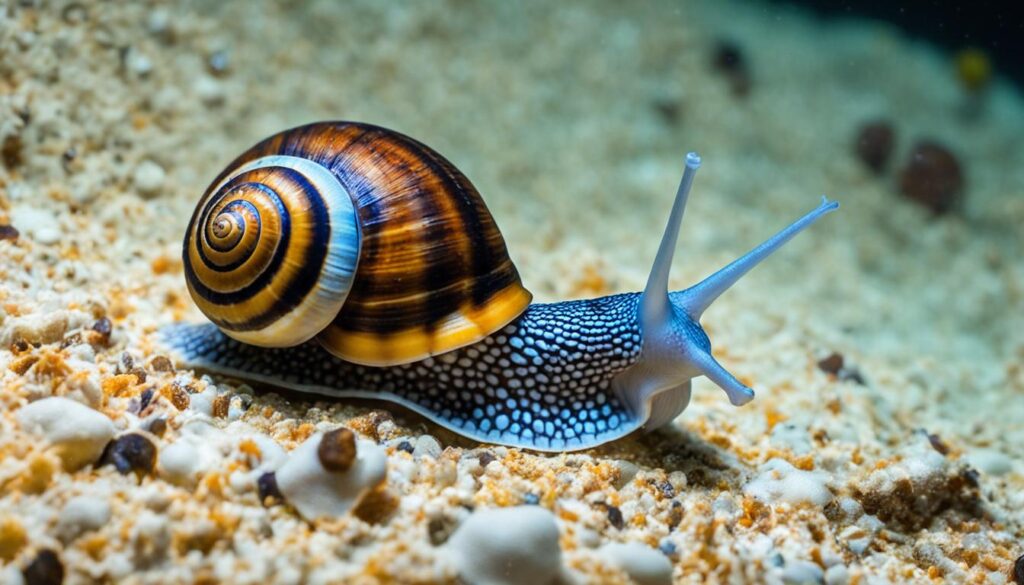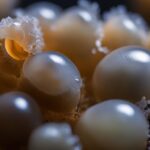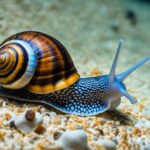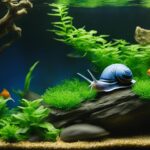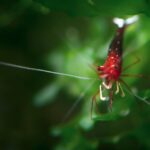The diligent care of marine invertebrates such as the Nassarius snail is pivotal to sustaining vibrant and healthy aquariums. These unassuming gastropods play an essential role in the maintenance and balance of aquatic environments, serving not just as an intriguing visual addition but as crucial custodians of the tank’s cleanliness. A properly cared for Nassarius snail can mean the difference between a thriving tank and one that struggles. This guide aims to provide aquarists with practical and insightful tips on Nassarius snail care, ensuring these beneficial gastropods remain active and healthy contributors to your underwater community.
Key Takeaways
- Nassarius snails are key players in the maintenance of a healthy aquarium ecosystem.
- Proper care for these gastropods includes understanding their needs and behaviors.
- Ensuring a clean tank with the right conditions is fundamental for Nassarius snail care.
- Knowledge of ideal tank setup, water parameters, and diet are crucial for gastropod maintenance.
- A healthy Nassarius snail population contributes to the overall balance and cleanliness of marine habitats.
Understanding the Nassarius Snail in Your Aquarium Ecosystem
The Nassarius snail, a prominent bottom feeder snail, plays a fundamental role in maintaining the health and cleanliness of a marine ecosystem. These hardy snails are not only fascinating in terms of their nassarius snail behavior but also pivotal in sustaining the underwater balance in home aquariums. They are particularly known for their scavenging tendencies, a behavior that ensures the tank’s substrate remains free from excess food and debris.
Equipped with a keen sense of smell, Nassarius snails emerge from their nassarius snail habitat in the sand or substrate to locate their food. They efficiently cycle nutrients and contribute to the overall health of the aquarium by converting waste materials into a form that is more easily processed by the aquarium’s filtration system.
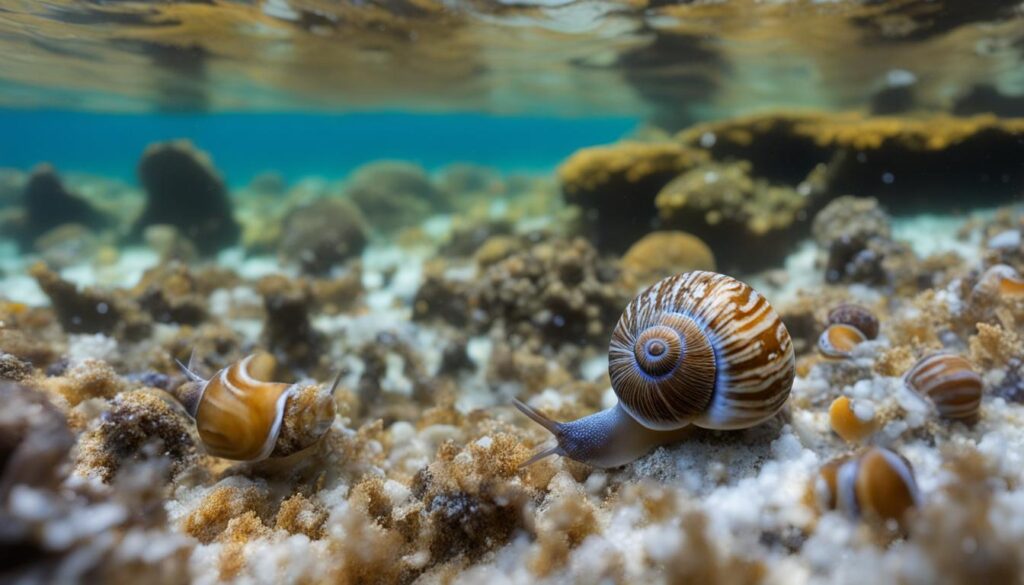
Keeping Nassarius snails in your aquarium not only aids in the tank’s tidiness but also provides observant aquarists with natural behavior that is fascinating to watch. The following table highlights some key behaviors and attributes of the Nassarius snail, offering insight into how they interact with their environment:
| Behavior | Description | Benefit to Aquarium |
|---|---|---|
| Burrowing | Disappears into the substrate, only emerging when detecting food | Provides natural aeration of the tank’s bed |
| Scavenging | Feeds on detritus, decaying matter, and leftover food | Keeps the aquarium clean and reduces waste buildup |
| Sensory Activity | Uses a siphon to smell out food from a distance | Engages in active foraging which can be stimulating for other tank inhabitants |
The intricate behaviors of the Nassarius snail, while seemingly minor, have significant repercussions on the stability and health of the marine environment they inhabit. Their activity stimulates the natural behaviors in other tank inhabitants, making them an asset to any marine aquarium committed to emulating an authentic underwater world.
Essential Nassarius Snail Care for Beginners
Embarking on the journey of nassarius snail care is an exciting endeavor for aquarium enthusiasts. Keeping these sandy substrate snails healthy and happy starts with understanding the basics of their environmental needs. From selecting the proper tank size to ensuring the right water conditions, every detail counts in creating an optimal habitat for your nassarius snail aquarium.
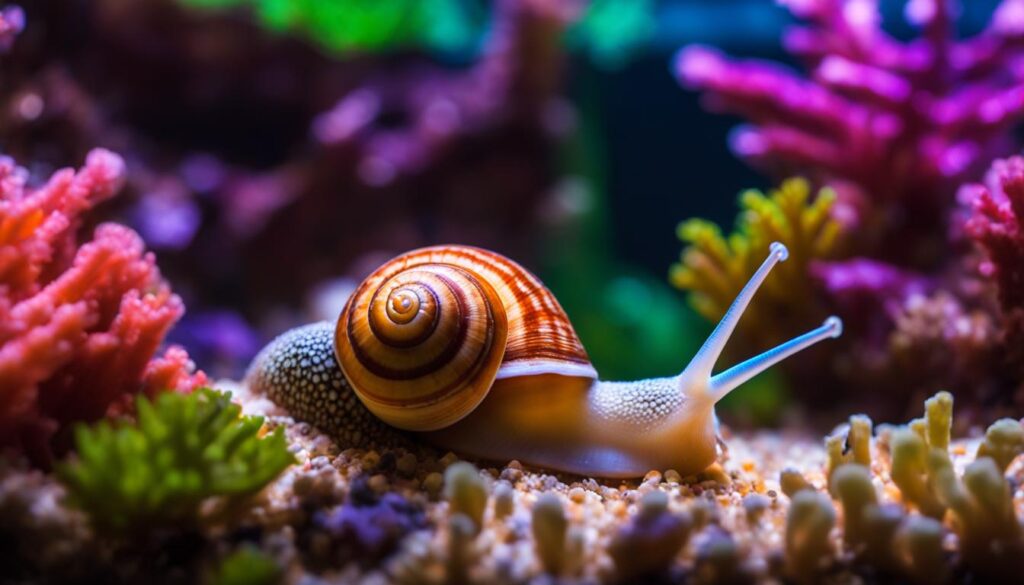
Selecting the Right Tank Size and Conditions
Space is a luxury in nature, and in the confines of an aquarium, the idea of spaciousness for nassarius snails translates into a sandy substrate for burrowing and ample room to roam. A larger tank not only provides this space but also aids in maintaining stable water parameters, critical for the wellbeing of your snails. Ideal tank conditions should mimic their natural coastal habitats, with a focus on emulating the tidal zones where nassarius snails thrive.
Maintaining Optimal Water Parameters for Nassarius Snails
Water quality is a pillar of nassarius snail care. Ensuring the right balance of temperature, salinity, pH, and hardness is pivotal for your gastropods’ health. Consistency in these water parameters prevents stress and promotes a thriving life for your marine companions.
| Parameter | Optimal Range |
|---|---|
| Temperature | 72-78°F (22-25.5°C) |
| Salinity | 1.023-1.025 specific gravity |
| pH | 8.1-8.4 |
| Hardness | 8-12 dKH |
Remember, regular monitoring and gradual adjustments will help keep your nassarius snail’s environment stable, preventing harmful fluctuations in these key water parameters.
Creating a Suitable Habitat for Nassarius Snails
For any aquarist dreaming of a thriving gastropod environment, understanding the needs of the nassarius snail habitat is paramount. A meticulously crafted aquarium setup not only fosters the health of these beneficial creatures but also enhances the overall aesthetics and balance of your marine ecosystem. Here’s how you can emulate their natural surroundings and provide a sanctuary for these industrious mollusks.
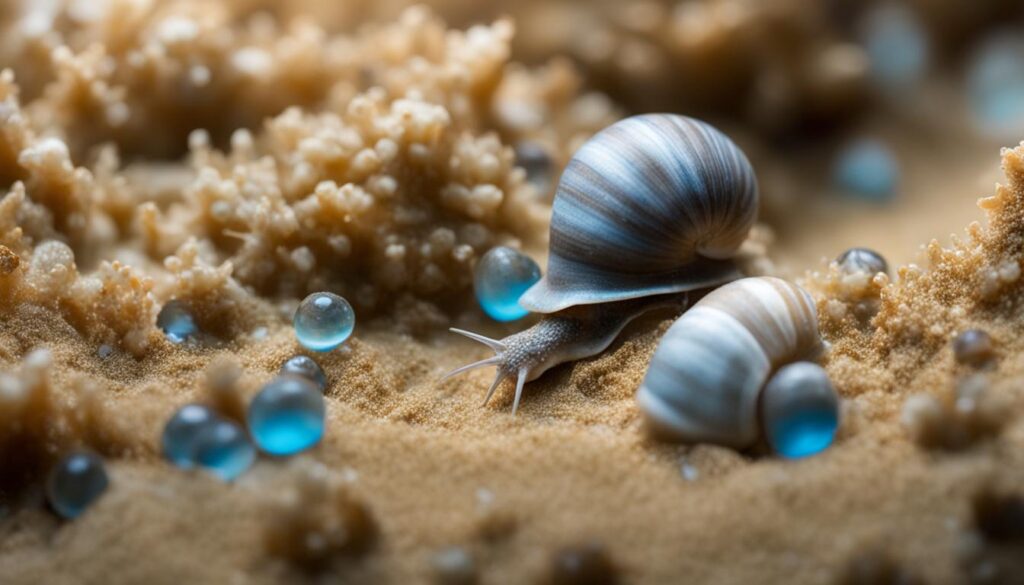
The substrates used in your tank play a significant role in imitating the nassarius snail habitat. A blend of sandy substrate, along with the addition of certain tank elements, creates an ambience that encourages nassarius snails to engage in their natural scavenging practices. Let’s dive into the details of what makes an ideal habitat:
| Feature | Description | Benefits for Nassarius Snails |
|---|---|---|
| Sandy Substrate | A fine-grained, sandy bottom | Simulates natural seabed and allows for easy burrowing |
| Live Rocks and Driftwood | Natural elements offering crevices to explore | Provides hiding spots and surfaces for algae growth |
| Aquatic Plants | Selection of seaweed and other marine plants | Enriches the habitat and aids in water filtration |
| Stable Water Parameters | Maintaining consistent salinity, temperature, and pH | Mirrors the stable conditions of their natural environment |
When these elements are synergistically combined, they create a robust and dynamic gastropod environment that nassarius snails will flourish in. Furthermore, the inclusion of live plants not only contributes to the visual appeal of your setup but also plays a crucial ecological role by oxygenating the water and providing a natural form of waste management.
- Choose a mix of plants that do well in brackish and marine setups.
- Consider the flow of water in your tank to ensure that detritus does not accumulate excessively.
- Introduce tankmates that are compatible with nassarius snails to maintain a harmonious community aquarium.
In conclusion, creating a tailored environment for your nassarius snails is a rewarding endeavor. By replicating the nassarius snail habitat, you not only cater to their well-being but also pave the way for a mesmerizing and healthy marine display.
The Ideal Diet for a Nassarius Snail
Ensuring your nassarius snails have access to the right nutrients is vital for their health and for the ecological balance of your aquarium. These scavengers play a critical role in tank cleanliness and contribute to a healthy gastropod diet. It’s essential to understand their natural feeding behaviors to provide adequate aquarium food sources.
Understanding Nassarius Snail Dietary Requirements
Nassarius snails are natural scavengers, often burrowing in substrate to seek out food. Their diet mainly consists of detritus, which includes decaying organic material such as dead fish, leftover food, and plant matter. In an aquarium setting, this behavior aids in keeping the tank clean by breaking down waste, thus contributing to a well-balanced environment.
Best Foods to Provide Your Nassarius Snails
While nassarius snails are adept at finding their own food, it is important to ensure they receive a varied diet for optimal health. Here are some suitable food options:
- Frozen or freeze-dried foods rich in meaty nutrients, such as mysis shrimp or brine shrimp
- Algae wafers or tablets, occasionally, as part of a balanced diet
- Small pieces of seafood like fish and squid, suitable for a carnivorous gastropod
These food sources can provide the necessary nutrients to support a nassarius snail diet within your aquarium’s ecosystem.
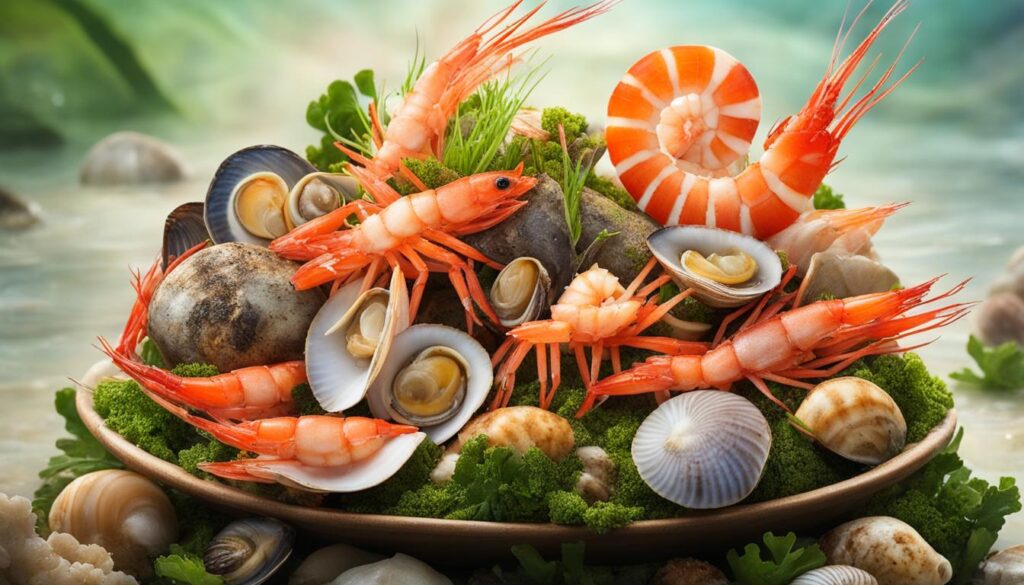
How to Feed Nassarius Snails in a Community Tank
When hosting nassarius snails in a community tank, it’s important to make sure all inhabitants receive their share of food. To accommodate your snails:
- Broadcast feeding: Lightly disperse food across the tank to ensure snails get a chance to feed on sinking pieces.
- Targeted feeding: For larger tanks, use feeding tongs to place food directly into the substrate, where nassarius snails are most likely to find it.
- Maintain feeding schedules: Regular, controlled feeding helps avoid overfeeding, which can lead to poor water quality and health issues for all tank inhabitants.
By offering a consistent supply of proper foods and monitoring consumption, you’ll support not only the nassarius snail diet but also the diet of other marine creatures in the tank.
Common Nassarius Snail Behavior and Health Indicators
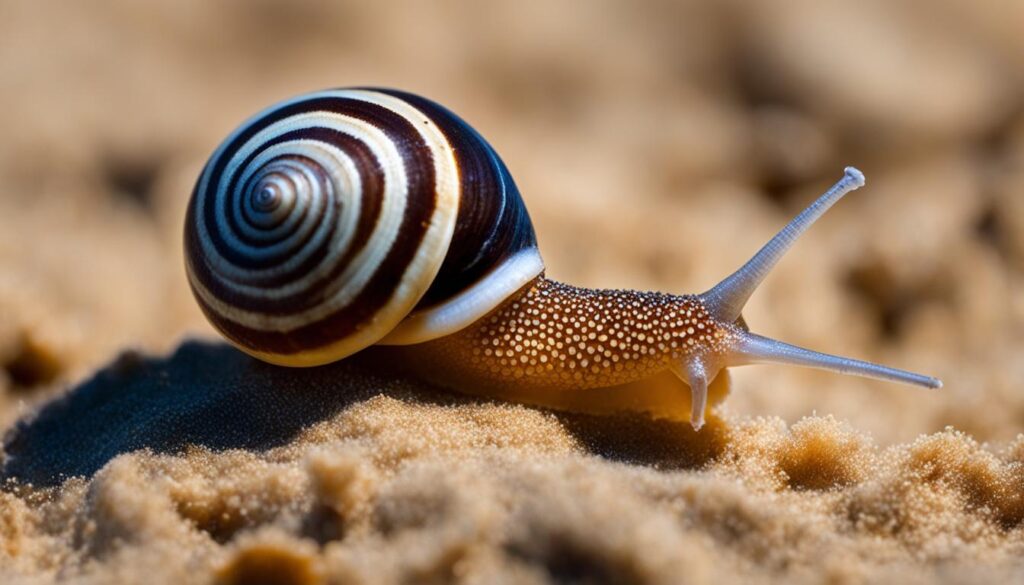
Observing the behavior of nassarius snails offers a window into their overall health and the conditions of their environment. The intriguing nassarius snail behavior is not only fascinating to witness but also serves as crucial nassarius snail indicators of well-being. Recognizing these behaviors is essential for maintaining gastropod health within your marine aquarium.
Common Healthy Behaviors:
- Active scavenging on the substrate surface and within the sand layers in search of food
- Quick retraction into their shells when disturbed, demonstrating a responsive reflex
- Display of a voracious appetite, especially following feeding times
- Regular burrowing activity that aids in aerating the substrate
Signs of Potential Distress:
- Lethargy or less frequent movement than usual can be a distress signal
- A lack of appetite or disregard for food offerings can indicate health issues
- Unusual floating for extended periods might point to water quality problems
- Excessive shell retraction and avoidance of normal social behaviors
By understanding and tracking nassarius snail activity, you become equipped to respond proactively to any changes that could impact the health of these valuable gastropods in your aquarium. Remember, consistency is key, and any changes in behavior should be monitored closely to ensure that the conditions within the tank remain optimal for your nassarius snails.
Nassarius Snail Species Identification and Diversity
The Nassarius genus hosts an array of fascinating snail species, each with distinct traits that enchant the dedicated marine enthusiast. In the interest of promoting greater marine invertebrate diversity within aquariums, it’s important to develop your skills in nassarius snail identification. Recognizing the nuanced differences amongst these species can greatly enhance your understanding and appreciation of your underwater community.
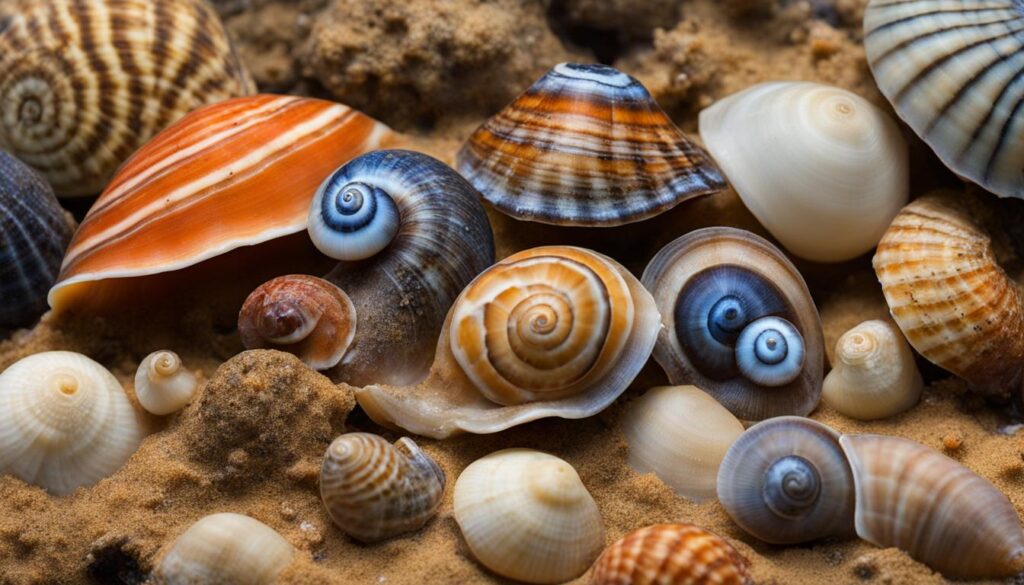
Differentiating Between Nassarius Snail Species
Key to any aquarist’s toolkit is the ability to distinguish between varieties of nassarius snail species. While some may look superficially similar, minute inspection reveals variances in shell shape, color, and size. Learning these differences is not merely an academic exercise—it can have practical implications for care and maintenance within your aquarium.
Unique Characteristics of Various Nassarius Snail Species
Certain species of Nassarius snails may adapt better to specific environments or have dietary preferences that set them apart from their cousins. As a result, they may contribute uniquely to the ecological balance of a saltwater habitat. Recognizing and accommodating for these unique characteristics ensures that each snail can thrive and perform its role in the tank’s miniature ecosystem.
- Nassarius vibex – Often preferred for smaller aquariums due to their diminutive size, these snails are diligent cleaners who burrow and help aerate the sandbed.
- Nassarius distortus – Exhibiting a more elongated shell, they are a species that can be more active during the day, making them a lively addition to the tank.
- Nassarius obstructus – Known for their larger shells, these are suitable for bigger tanks where they can forage without disruption to other inhabitants.
By understanding the diversities within the Nassarius genus, aquarists can better curate their collections, ensuring a harmonious and vibrant marine invertebrate community.
Promoting Healthy Nassarius Snail Reproduction
Creating a balanced and thriving marine environment for Nassarius snails includes understanding and overseeing their reproductive behaviors. A keen eye on snail mating behaviors and managing snail population numbers contributes to the health of both individual snails and the overall aquarium ecosystem. Below are key insights into facilitating a controlled breeding environment and ensuring the vitality of your marine habitat through proper nassarius snail reproduction management.
Recognizing Nassarius Snail Mating Behaviors
Observing the interactions of Nassarius snails can be fascinating. To ensure a thriving reproductive environment, it is essential to identify when your snails are ready to mate. Snail mating behaviors often include a noticeable increase in activity, with snails moving closer and becoming more social with potential mates. You might spot two snails adhering to one another in a mating dance, which typically precedes egg laying. Monitoring such behaviors allows aquarists to not only enjoy the wonders of marine life but also to prepare for the management of the upcoming population.
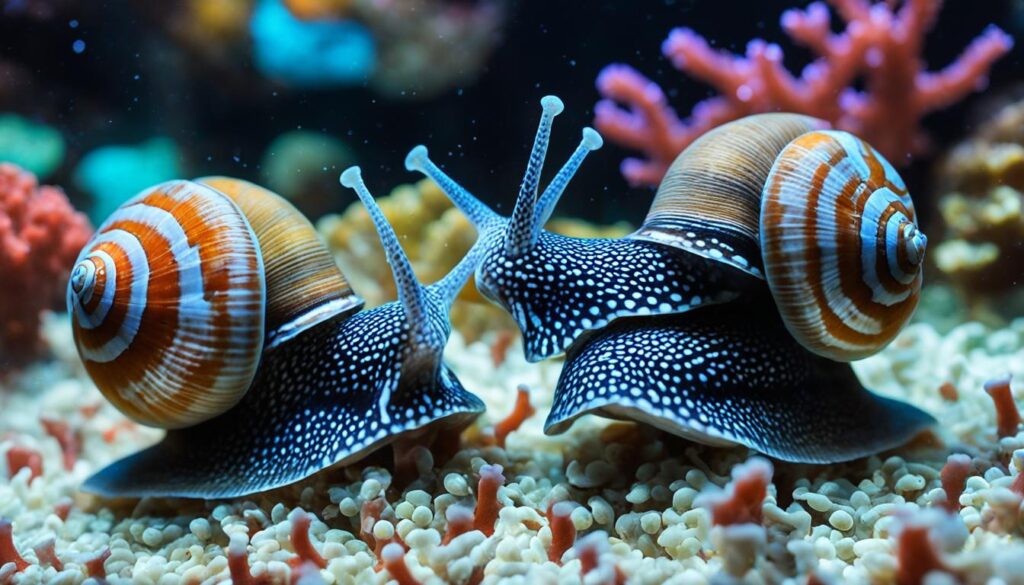
Management of Nassarius Snail Population in Aquariums
Contemporary aquariums warrant a careful balance, with overcrowding being a potential hazard. Properly managing snail population growth is integral to maintaining this balance. This might involve isolating breeding pairs, regulating breeding periods, or rehoming excess snails to fellow enthusiasts or local pet stores. Monitoring the population is also critical for preventing excessive bioload, which can lead to diminished water quality and increased stress on both the snails and other tank inhabitants.
- Isolate breeding individuals if you need to manage the timing and quantity of offspring.
- Limit the number of snails to a ratio that is sustainable for the size and biodiversity of your tank.
- Donate or sell surplus snails to control population density and ensure each individual snail has adequate space and resources.
The Environmental Benefits of Hosting Nassarius Snails
Welcome to the insightful journey of understanding how nassarius snail benefits extend far beyond their petite shells. These unassuming gastropods are not just tank inhabitants but vital participants in maintaining the delicate balance of a marine ecosystem. Let’s dive into the significant roles they play in aquarium cleanup and contributing to the essential nitrogen cycle.
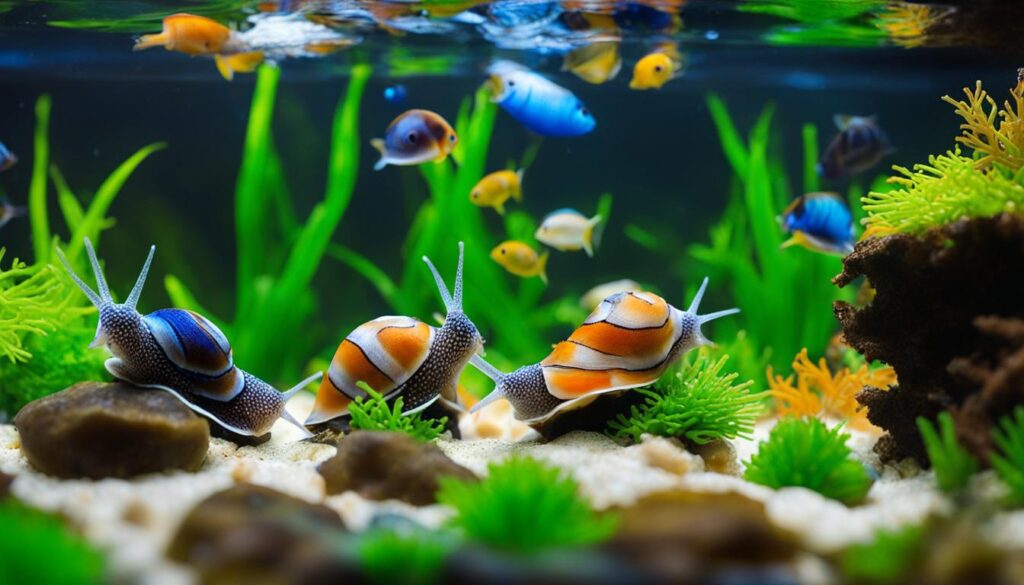
Nassarius Snails’ Role in Tank Cleanup and Maintenance
Nassarius snails serve as effective custodians of the underwater world in home aquariums. By nature, they are scavengers, primarily feasting on detritus and uneaten food that accumulates in the tank. This not only keeps the aquarium clean but also prevents the buildup of harmful compounds that can affect the health of other marine life.
- Reducing algae and biofilm on surfaces
- Preventing detritus and decomposing organics from accumulating
- Mitigating the risk of ammonia spikes due to decomposing food
Contributions to the Nitrogen Cycle and Overall Tank Health
When it comes to the nitrogen cycle, nassarius snails play a critical but often understated role. Their constant movement through the substrate aids in the aeration of the tank bed, promoting the growth of beneficial bacteria. These bacteria are integral to breaking down ammonia into nitrites and then nitrates, which are less harmful to the aquarium inhabitants.
| Nitrogen Cycle Stage | Role of Nassarius Snail | Benefit to Aquarium |
|---|---|---|
| Ammonia Reduction | Consumes organic waste, reducing ammonia levels | Prevents toxicity for fish and other invertebrates |
| Nitrite to Nitrate Conversion | Aerates substrate for bacteria colonization | Facilitates the natural filtration process |
| Nitrate Management | Helps in the overall reduction of nitrates by maintaining a clean environment | Supports long-term health and stability of marine life |
By examining the contributions of nassarius snails to both tank cleanliness and the nitrogen cycle, it’s clear that these snails are indispensable allies in achieving a thriving aquarium environment. Their relentless pursuit of waste not only ensures a cleaner habitat but also bolsters the overall dynamics needed for sustaining a healthy marine ecosystem.
Conclusion
Embarking on the rewarding journey of maintaining nassarius snails requires dedication, but it promises immense benefits for your aquarium’s vitality. These diligent marine gastropods are key contributors to a thriving aquarium ecosystem, thanks to their scavenging habits and the active role they play in the nitrogen cycle. Ensuring the long-term health of your nassarius snails hinges on the commitment to replicating their natural habitat as closely as possible, providing them with a balanced diet, and monitoring their behavior for signs of well-being.
Throughout this guide, we’ve delved into the nuances of nassarius snail care, from selecting the perfect tank environment to grasping their unique dietary needs. It’s clear that the success of these creatures parallels the overall health of your marine ecosystem. A well-maintained habitat and conscientious attention to water quality and optimum conditions heavily influence not just the snails but every organism in your care.
In conclusion, the significant role nassarius snails play cannot be overstated. With mindful practices in place for their care, enthusiasts can watch their underwater communities flourish. Keep these guidelines at the forefront as you cultivate an enviable aquatic world—that under your guidance—echoes the diversity and splendor of the ocean’s own vast ecosystems.
FAQ
What is a Nassarius Snail and why is it important for my aquarium?
A Nassarius Snail is a marine invertebrate known for burrowing in sandy substrates and acting as a bottom feeder in your tank. They are important for healthy aquariums because they help keep the substrate clean by consuming detritus and uneaten food, reducing waste and contributing to a balanced ecosystem.
How do Nassarius Snails contribute to the cleanliness of my marine habitat?
Nassarius Snails help to keep your aquarium clean by scavenging for detritus, dead organisms, and leftover food that have fallen to the bottom. Their burrowing behavior helps to aerate the sand and prevent the build-up of harmful gases.
What are the ideal tank conditions for Nassarius Snails?
Nassarius Snails thrive in tanks that have a sandy substrate and plenty of hiding places. The tank should be well-filtered with stable water parameters, including appropriate temperature, salinity, pH, and hardness levels specific to the needs of marine life.
How do I create a habitat that mimics the natural environment of Nassarius Snails?
To mimic their natural environment, you should provide a sandy substrate for burrowing, live rock or decorations for hiding, and possibly live plants. Adequate space and clean, quality water are also necessary for these scavengers to thrive.
What does a healthy diet for Nassarius Snails include?
A healthy diet for Nassarius Snails consists of a variety of foods such as detritus, leftover fish food, dead plant material, and occasionally dead organisms. In captivity, they may also eat sinking pellets or frozen meaty foods specifically formulated for marine snails.
How can I recognize if my Nassarius Snail is healthy?
Healthy Nassarius Snails are active scavengers that will respond quickly to the presence of food. They should have a smooth, uncracked shell and exhibit regular burrowing behavior. Signs of distress could include inactivity or floating on the water’s surface.
How can I differentiate between Nassarius Snail species?
Different Nassarius Snail species can vary in size, color, and shell shape. Some species may have thicker shells or more pronounced spiral ridges. Observing these physical characteristics can help identify the specific species in your aquarium.
What should I know about Nassarius Snail reproduction in my tank?
Nassarius Snails are capable of reproducing in captivity. You might witness mating behaviors like clustering and following each other. It’s important to manage their population as overbreeding can lead to issues with tank balance and resources.
What environmental benefits do Nassarius Snails offer in an aquarium?
Nassarius Snails play a crucial role in maintaining tank cleanliness which helps sustain a healthy nitrogen cycle. They remove organic waste, reduce algae growth, and promote a balanced and healthy ecosystem in your marine aquarium.

